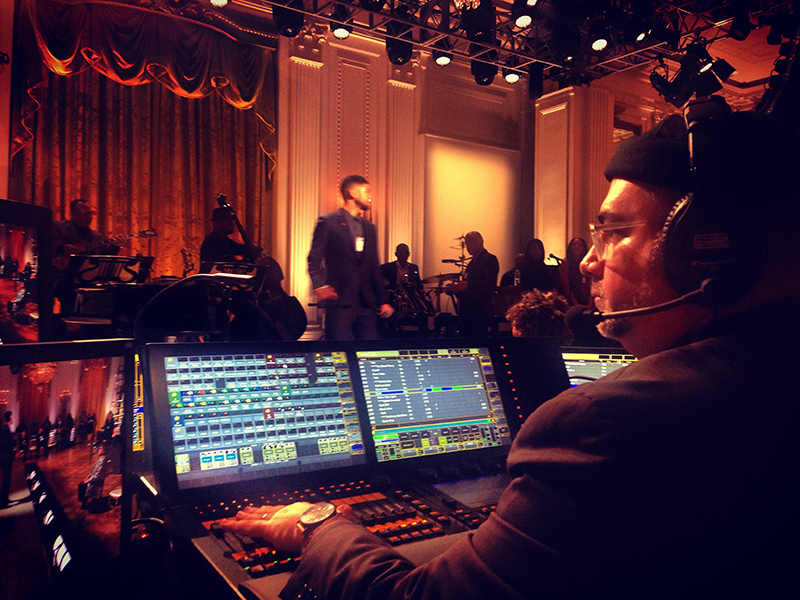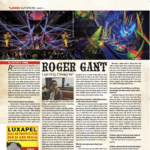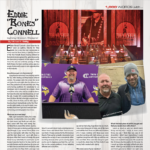
Michael Appel is an award-winning lighting designer and programmer, with five Emmy nominations and three wins. He’s worked extensively on broadcast television shows and industrials where he specializes in large-scale award shows and live music productions. Among his programming credits are Kids Choice Awards, Teen Choice Awards, CNN Heroes, MTV Video Music Awards, Pitbull’s New Year’s Revolution, CMT Music Awards, The iHeart Radio Music Festival, The NBA All-Star Game, The Mark Twain Prize, and In Performance at the White House. Appel was a lighting director on HNTV’s 2018 New Year’s Gala in China, which broadcast live to 450 million viewers. His designs include The 2019 Disney Upfront, select performances for Christmas in Rockefeller Center (NBC), Mary Kay Leadership Conference, launch of the Maserati Levante Trofeo at the 2018 New York International Auto Show and the 2019 RAM Heavy Duty Trucks press event at the International Auto Show in Detroit. Appel’s company is MADesign. You can see more of his work at madesign.tv.
PLSN: How did you get started?
Michael Appel: At 15, I played double bass for a community orchestra that rehearsed on stage at Kingsborough Community College in Brooklyn, which was also a theatrical roadhouse. The guy in charge of the orchestra setup, Ed Rohrlich, hired me to help set up the chairs and stands. Then Greg Sutton, who ran the theater, asked if I wanted to unload a truck for The Mystery of Edwin Drood national tour. This theater was used to check out national tours, including Cabaret and Dream Girls, so I started pushing scenery around as a teen. Then I realized I was interested in the lighting side, so I started hanging out with the lighting crew. That was my job through high school and a lot of great LDs come through there; Jennifer Tipton, Dennis Parichy, and others; it was great. I was working as a stagehand and as an electrician. By the time I was a senior in high school I had started getting electrician jobs off, off Broadway.
I went to Brooklyn College and that was a great experience, especially in their roadhouse. I had two mentors there, the TD of the student space Michael Hairston, and the head electrician of the roadhouse Steve Bailey. Both were really wonderful; just drove me in the right direction. While in college, I worked at the Santa Fe Opera, first as an apprentice and then the following year as a shop electrician, that was when LD Craig Miller was still alive. He had a big influence on me, in terms of work ethic and the precision of how you have to do things.
When did you cross over into TV lighting?
I started in television in the props department on Cosby (CBS), a friend of mine from Kingsborough, Chris Dono, recommended me for over-hire and I was eventually offered a permanent job in props. This was October of ‘97. There I met the gaffer Tony Santoro and lighting designer Bill Berner. The following season, I wound up on the light board, working for Bill. After that, I stayed in television and never left.
How did you move into programming?
Back then, I was running conventionals on an ETC Expression 2X console and the movers would be run on a separate console like the Wholehog. I’d look over at the moving light-only programmers and think that we were doing the same work, but they were getting paid double what I was. Maybe I should reevaluate what I was doing. Then 9/11 hit and all the work on shows that I had lined up was cancelled. No one wanted to shoot in New York. That is when I flew to Austin, TX and got trained on the Wholehog console and came away with a beginner Wholehog card.
I didn’t get any work programming moving lights right away. I got a studio lighting job at Sesame Street for a season, working with lighting designer Dan Kelley. It was a fun and very educational experience. I was working with LDs like Otis Howard and Chris Landy. Chris asked me if I could program moving lights and I said sure. It was on a grandMA, which I hadn’t trained on, so I had Patrick Dierson on speed dial. That shoot went well and Chris recommended me to Dan Kelley for the moving light programming on the VMA Red Carpet at Radio City, which also went well, and pretty much, after that I was only programming moving lights. I started moving from one show to the next; it was all word of mouth. Moving into the large-scale award shows, happened because of my relationship with Tom Kenny. I was recommended to Tom by a gaffer named Eugene Meinhofer in New York. That was about 15, 16 years ago now. Tom creates some interesting looking shows; it’s been a great relationship working with him. I have greatly appreciated that relationship in my career.
What’s the essential element needed in the programmer/lighting designer relationship?
You have to allow the designer to edit your work. That’s really what it boils down to. You have to be egoless in that relationship. I think it’s essential, that you can work autonomously, and you understand the direction the LD gives you is the direction that he’s received from the producers. You understand what the show wants to be, and you work away at it. And when he or she comes to you and says, ‘You know, I really think that should be blue.’ even though you’ve worked on something for two hours and you think it’s the coolest thing ever, you say, ‘Absolutely, it’s blue now.’ You’re working towards a common goal, but in the end, the designer is the arbiter of what the show needs to be.
Also, having patience and just being able to just let the show develop. It depends on which LDs you work with; some are very quick, and some are methodical and want to go through a lot of different steps. Understanding that everyone’s different and just let it flow with those different personalities is a lot of it. It’s about situational awareness. It’s knowing when to interject your idea and your thought, and when to lay back and just let the creative team tell you what their vision is and what they want to see.
What do you enjoy most about your career?
I enjoy that things are different all the time. Every show, even year over year annual award shows, are a new challenge with new scenery, new music. You’re constantly looking at things in new ways because you’re always posed a new challenge.
What surprised you most about your path?
When I went to college, my mother thought that I would get a job at the opera house in Brooklyn. I thought I was going to go to Broadway and be a designer; that was the dream. The world I’m in now, I didn’t even know existed then. I am fortunate enough to make a decent living, take care of my family, and do what I enjoy doing. Every now and then I take a step back and think, ‘Oh wow, I actually do work on some cool projects.’ That’s pretty nice to be able to say about your career.


